SQL
Server built-in functions are either deterministic or nondeterministic.
Functions are deterministic when they always return the same result any
time they are called by using a specific set of input values. Functions
are nondeterministic when they could return different results every
time they are called, even with the same specific set of input values.
Functions
that take a character string input and return a character string output
use the collation of the input string for the output. Functions that
take no character inputs and return a character string use the default
collation of the current database for the output. Functions that take
multiple character string inputs and return a character string use the
rules of collation precedence to set the collation of the output string
In
this article I am going to explain about some SQL Server 2005 functions
with examples. A function performs an operation and returns a value. A
function consists of the function name, followed by a set of
parenthesis that contains any parameter or arguments required by the
function. If a function requires two or more arguments you can separate
them with commas.
Here are going to discuss about some string functions, numeric functions and date/time functions.
Note - I am using my own database table for examples. See database table in figure 1.

Figure 1.
String Functions
1. LEN (string) - Returns the number of characters of the specified string expression, excluding trailing blanks.
Example:
use Vendor
GO
Select LEN('Raj'), LEN('Raj ') FROM VENDOR WHERE VendorFName='Raj'
GO
LEN doesn't count length of spaces. So result looks like this.

2. LTRIM (string) - LTRIM function to return a character expression after removing leading spaces.
Example:
use Vendor
GO
use Vendor
SELECT LTRIM(' Raj')
FROM VENDOR WHERE VendorFName='Raj'
Go

3. RTRIM (string) - RTRIM function to return a character expression after removing trailing spaces.
Example:
use Vendor
GO
use Vendor
Select RTRIM('Raj ')
FROM VENDOR WHERE VendorFName='Raj'
GO

4. LEFT (string, length) - Returns the specified number of characters from the beginning of the string.
Example:
use Vendor
SELECT VendorFName, VendorLName, LEFT(VendorFName, 1) + LEFT (VendorLName, 1) AS Initials FROM Vendor

5. RIGTH (string, length) - Returns the specified number of characters from the end of the string.
Example:
use Vendor
SELECT VendorFName, VendorLName, RIGHT(VendorFName, 1) + RIGHT (VendorLName, 1) AS Initials FROM Vendor
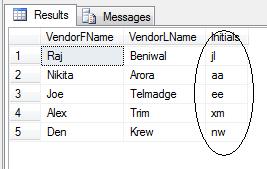
6. SUBSTRING (string, start, length) - Returns the specified number of characters from the string starting at the specified position.
Example:
use Vendor
GO
SELECT SUBSTRING('beniwal', 2, 2) FROM VENDOR WHERE VendorFName='Raj'
GO

7. REPLACE (search, find, replace) - Returns the search string with all occurrences of the find string replaced with the replace string.
Example:
use Vendor
GO
use Vendor
SELECT REPLACE('Beniwal', 'Beniwal', 'Choudhary')
FROM VENDOR WHERE VendorFName='Raj'
GO

8. REVERSE (string) - Returns the string with the character in reverse order.
Example:
use Vendor
GO
use Vendor
SELECT REVERSE('Raj')
FROM VENDOR WHERE VendorFName='Raj'
GO

9. CHARINDEX (find, search [, start]) - Returns
an integer that represents the position of the first occurrence of the
find string in the search string starting at the specified position. If
the starting position isn't specified, the search starts at the
beginning of the string. If the staring isn't found, the functions
returns zero.
Example:
use Vendor
GO
use Vendor
SELECT CHARINDEX('w', 'Beniwal')
FROM VENDOR WHERE VendorFName='Raj'
GO

10. PATINDEX (find, search [, start]) - PATINDEX
is useful with text data types; it can be used in a WHERE clause in
addition to IS NULL, IS NOT NULL, and LIKE (the only other comparisons
that are valid on text in a WHERE clause). If either pattern or
expression is NULL, PATINDEX returns NULL when the database
compatibility level is 70. If the database compatibility level is 65 or
earlier, PATINDEX returns NULL only when both pattern and expression are
NULL.
Example:
use Vendor
GO
use Vendor
SELECT PATINDEX('%Krew%', VendorLName)
FROM VENDOR WHERE VendorId=5
GO

11. LOWER (string) - Returns the string converted to lowercase letters.
Example:
use Vendor
GO
use Vendor
SELECT LOWER('Raj')
FROM VENDOR WHERE VendorFName='Raj'
GO

12. UPPER (string) - Returns the string converted to uppercase letters.
Example:
use Vendor
GO
use Vendor
SELECT UPPER('Raj')
FROM VENDOR WHERE VendorFName='Raj'
GO

13. SPACE (integer) - Returns the string with the specified number of space characters (blanks).
Example:
use Vendor
GO
use Vendor
SELECT VendorFName + ',' + SPACE(2) + VendorLName
FROM VENDOR WHERE VendorFName='Raj'
GO
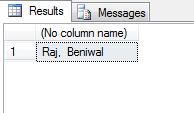
Numeric Functions
1 ROUND (number, length, [function]) - Returns
the number rounded to the precision specified by length. If length is
positive, the digits to the right of the decimal point are rounded. If
it's negative the digits to the left of the decimal point are rounded.
To truncate the number rather than round it code a non zero value for
function.
Example:
USE Vendor
GO
--Used Round the estimates
SELECT ROUND(123.9994, 3), ROUND(123.9995, 3)
--Use ROUND and rounding approximations
SELECT ROUND(123.4545, 2), ROUND(123.45, -2)
--Use ROUND to truncate
SELECT ROUND(150.75, 0), ROUND(150.75, 0, 1)
GO
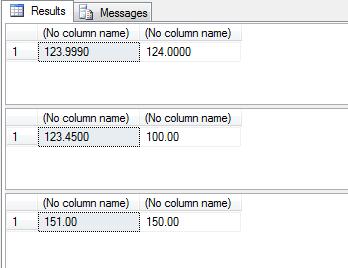
2 ISNUMERIC(expressions) - Returns a value of 1 (true) if the expression is a numeric value; returns a values of 0 (false) otherwise.
Example:
USE Vendor
GO
SELECT IsNumeric(VendorId) FROM Vendor
SELECT ISNumeric(VendorFName) FROM Vendor
GO
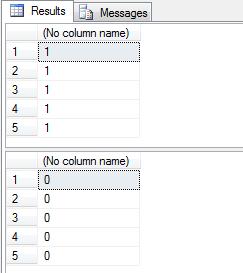
3 ABS (number) - Returns the absolute value of number.
Example:
USE Vendor
GO
SELECT ABS(-1.0), ABS(0.0), ABS(1.0)
GO

4 CEILING (number) - Returns the smallest integer that is greater than or equal to the number.
Example:
USE Vendor
GO
SELECT CEILING($123.45),CEILING($-123.45), CEILING($0.0)
GO

5 FLOOR (number) - Is an expression of the exact numeric or approximate numeric data type category, except for the bit data type.
Example:
USE Vendor
GO
SELECT FLOOR(123.45), FLOOR(-123.45), FLOOR($123.45)
GO

6 SQUARE (float_number) - Returns the square of the given expression.
Example:
USE Vendor
GO
DECLARE @h float, @r float
SET @h = 5
SET @r = 1
SELECT PI()* SQUARE(@r)* @h AS 'Cyl Vol'
GO

7 SQRT (float_number) - Returns a square root of a floating-point number.
Example:
USE Vendor
GO
DECLARE @myvalue float
SET @myvalue = 1.00
WHILE @myvalue < 10.00
BEGIN
SELECT SQRT(@myvalue)
SELECT @myvalue = @myvalue + 1
END
GO
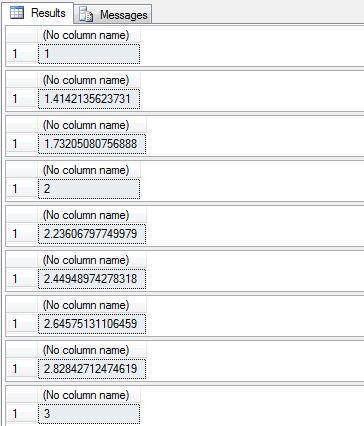
8 RAND ([seed]) - Returns a random float value from 0 through 1.
Seed
Is
an integer expression (tinyint, smallint, or int) that specifies the
seed value. If seed is not specified, Microsoft SQL Server 2000 assigns a
seed value at random. For a given seed value, the result returned is
always the same.
Example:
USE Vendor
GO
DECLARE @counter smallint
SET @counter = 1
WHILE @counter < 5
BEGIN
SELECT RAND() Random_Number
SET NOCOUNT ON
SET @counter = @counter + 1
SET NOCOUNT OFF
END
GO

Date/Time Functions:
1 GetDate () - Returns the current system date and time in the Microsoft SQL Server standard internal format for date time values.
Example:
USE Vendor
GO
SELECT GetDate()
GO
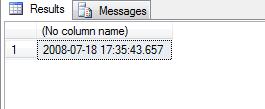
2 GETUTCDATE() - Returns
the current UTC date and time based on the system's clock and time zone
setting. UTC (Universal Time Coordination) is the same as Greenwich
Mean Time.
Example:
USE Vendor
GO
SELECT GETUTCDATE()
GO

3 DAY (date) - Returns the day of the month as an integer.
Example:
USE Vendor
GO
SELECT DAY('03/12/1998') AS 'Day Number'
GO

4 MONTH (date) - Returns the month as an integer.
Example:
USE Vendor
GO
SELECT "Month Number" = MONTH('03/12/1998')
SELECT MONTH(0), DAY(0), YEAR(0)
GO
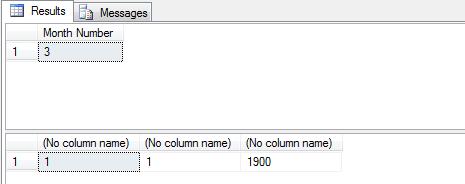
5 YEAR (date) - Returns the 4-digit year as an integer.
Example:
USE Vendor
GO
SELECT "Year Number" = YEAR('03/12/1998')
GO

6 DATENAME (datepart, date) - Returns an integer representing the specified date part of the specified date.
Example:
USE Vendor
GO
SELECT DATENAME(month, getdate()) AS 'Month Name'
GO

7 DATEPART(datepart, date)
Is
the parameter that specifies the part of the date to return? The table
lists date parts and abbreviations recognized by Microsoft SQL Server.
|
Datepart
|
Abbreviations
|
|
year
|
yy, yyyy
|
|
quarter
|
qq, q
|
|
month
|
mm, m
|
|
dayofyear
|
dy, y
|
|
day
|
dd, d
|
|
week
|
wk, ww
|
|
weekday
|
dw
|
|
hour
|
hh
|
|
minute
|
mi, n
|
|
second
|
ss, s
|
|
millisecond
|
ms
|
The
week (wk, ww) datepart reflects changes made to SET DATEFIRST. January 1
of any year defines the starting number for the week datepart, for
example: DATEPART(wk, 'Jan 1, xxxx') = 1, where xxxx is any year.
The
weekday (dw) datepart returns a number that corresponds to the day of
the week, for example: Sunday = 1, Saturday = 7. The number produced by
the weekday datepart depends on the value set by SET DATEFIRST, which
sets the first day of the week.
Date
Is
an expression that returns a datetime or smalldatetime value, or a
character string in a date format. Use the datetime data type only for
dates after January 1, 1753. Store dates as character data for earlier
dates. When entering datetime values, always enclose them in quotation
marks. Because smalldatetime is accurate only to the minute, when a
smalldatetime value is used, seconds and milliseconds are always 0.
If
you specify only the last two digits of the year, values less than or
equal to the last two digits of the value of the two digit year cutoff
configuration option are in the same century as the cutoff year. Values
greater than the last two digits of the value of this option are in the
century that precedes the cutoff year. For example, if two digit year
cutoff is 2049 (default), 49 is interpreted as 2049 and 2050 is
interpreted as 1950. To avoid ambiguity, use four-digit years.
For more information about specifying time values, see Time Formats. For more information about specifying dates, see datetime and smalldatetime.
Example :
USE Vendor
GO
SELECT GETDATE() AS 'Current Date'
SELECT DATEPART(month, GETDATE()) AS 'Month Number'
SELECT DATEPART(m, 0), DATEPART(d, 0), DATEPART(yy, 0)
GO
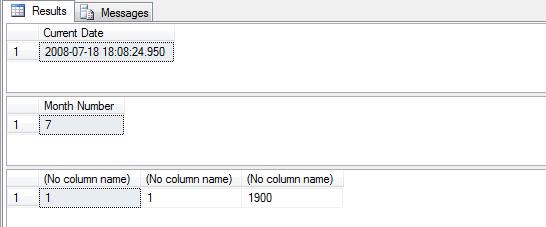
8 DATEADD (datepart, number, date) - Returns the date that results from adding the specified number of datepart units to the date.
Example -
USE Vendor
GO
SELECT DATEADD(day, 21, PostedDate) AS timeframe FROM Vendor
GO
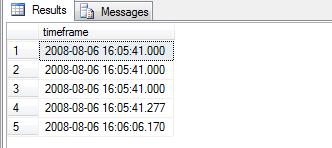
9 DATEDIFF (datepart, startdate, enddate) - Returns the number of datepart units between the specified start date and end date.
Example:
USE Vendor
GO
SELECT DATEDIFF(day, posteddate, getdate()) AS no_of_days
FROM Vendor WHERE VendorFName='Raj'
GO

10 ISDATE (expression) - Returns a value of 1(true) if the expression is a valid date/time value; returns a value of 0(false) otherwise.
Example:
USE Vendor
GO
DECLARE @datestring varchar(8)
SET @datestring = '12/21/98'
SELECT ISDATE(@datestring)
GO

More Functions -
1 CASE - Evaluate a list of conditions and returns one of multiple possible return expressions.
CASE has two formats:
-
The simple CASE function compares an expression to a set of simple expressions to determine the result.
-
The searched case function evaluates a set of boolean expressions to determine the result.
Syntax:
Simple CASE function:
CASE input_expression
WHEN when_expression THEN result_expression
[...n]
[
ELSE else_result_expression
]
END
Searched CASE function:
CASE
WHEN Boolean_expression THEN result_expression
[...n]
[
ELSE else_result_expression
]
END
Example:
use Vendor
GO
SELECT VendorId, VendorFName, VendorLName,
CASE VendorId
WHEN 1 THEN 'This is vendor id one'
WHEN 2 THEN 'This is vendor id two'
WHEN 3 THEN 'This is vendor id three'
WHEN 4 THEN 'This is vendor id four'
WHEN 5 THEN 'this is vendor id five'
END AS PrintMessage
FROM Vendor
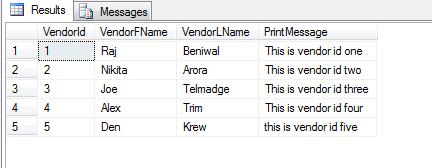
2 COALESCE - Returns the first nonnull expression among its arguments.
Syntax:
COALESCE (expression [...n])
Example:
use Vendor
GO
SELECT PostedDate, COALESCE(PostedDate, '1900-01-01') AS NewDate
FROM Vendor
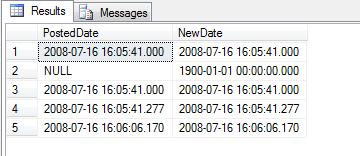
3 ISNULL - Replaces NULL with the specified replacement value.
Syntax:
ISNULL (check_expression, replacement_value)
Example:
use Vendor
GO
SELECT PostedDate, ISNULL(PostedDate, '1900-01-01') AS NewDate
FROM Vendor
GO

4 GROUPING - Is
an aggregate function that causes an additional column to be output
with a value of 1 when the row is added by either the CUBE or ROLLUP
operator, or 0 when the row is not the result of CUBE or ROLLUP.Grouping
is allowed only in the select list associated with a GROUP BY clause
that contains either the CUBE or ROLLUP operator.
Syntax: GROUPING (column_name)
Example -
Use Vendor
GO
SELECT royality, SUM(advance) 'total advance', GROUPING(royality) 'grp'
FROM advance
GROUP BY royality
WITH ROLLUP
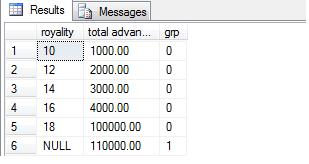
5 ROW_Number() - Returns the sequential number of a row within a partition of a result set, starting at 1 for the first row in each partition
Syntax: ROW_NUMBER ( ) OVER ([<partition_by_clause>] <order_by_clause>)
Note: The
ORDER BY in the OVER clause orders ROW_NUMBER. If you add an ORDER BY
clause to the SELECT statement that orders by a column(s) other than
'Row Number' the result set will be ordered by the outer ORDER BY.
Example:
Use Vendor
GO
SELECT VendorFName, VendorLName,
ROW_Number() Over(ORDER BY PostedDate) AS 'Row Number'
FROM Vendor
GO
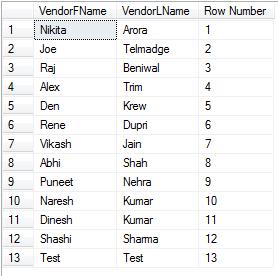
6 RANK () - Returns
the rank of each row within the partition of a result set. The rank of a
row is one plus the number of ranks that come before the row in
question.
Syntax: RANK ( ) OVER ([< partition_by_clause >] < order_by_clause >)
Arguments: < partition_by_clause >
Divides
the result set produced by the FROM clause into partitions to which the
RANK function is applied. For the syntax of PARTITION BY, see OVER
Clause (Transact-SQL).
< order_by_clause >
Determines
the order in which the RANK values are applied to the rows in a
partition. For more information, see ORDER BY Clause (Transact-SQL). An
integer cannot represent a column when the < order_by_clause > is
used in a ranking function.
Example:
Use Vendor
GO
SELECT VendorId, VendorFName, VendorLName,
RANK() Over(PARTITION BY PostedDate ORDER BY VendorId) AS 'RANK'
FROM Vendor ORDER BY PostedDate DESC
GO
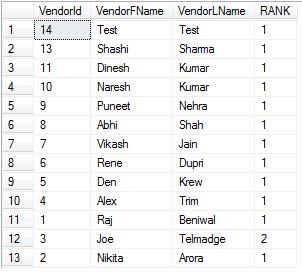
7 DENSE_RANK ()
- Returns the rank of rows within the partition of a result set,
without any gaps in the ranking. The rank of a row is one plus the
number of distinct ranks that come before the row in question.
Syntax: DENSE_RANK ( ) OVER ([< partition_by_clause >] < order_by_clause >)
Arguments: < partition_by_clause >
Divides
the result set produced by the FROM clause into partitions to which the
DENSE_RANK function is applied. For the syntax of PARTITION BY, see
OVER Clause (Transact-SQL).
< order_by_clause >
Determines
the order in which the DENSE_RANK values are applied to the rows in a
partition. An integer cannot represent a column in the
<order_by_clause> that is used in a ranking function.
Example :
Use Vendor
GO
SELECT VendorId, VendorFName, VendorLName,
DENSE_RANK() OVER(PARTITION BY PostedDate ORDER BY VendorId) AS 'DENSE RANK'
FROM Vendor ORDER BY PostedDate DESC
GO
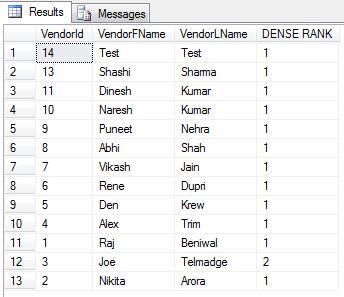
NTILE (integer_expression) -
Distributes the rows in an ordered partition into a specified number of
groups. The groups are numbered, starting at one. For each row, NTILE
returns the number of the group to which the row belongs.
Syntax: NTILE (integer_expression) OVER ([<partition_by_clause>] < order_by_clause >)
Arguments: integer_expression
Is
a positive integer constant expression that specifies the number of
groups into which each partition must be divided? integer_expression can
be of type int, or bigint.
Note:
integer_expression
can only reference columns in the PARTITION BY clause.
integer_expression cannot reference columns listed in the current FROM
clause.
<partition_by_clause>
Divides
the result set produced by the FROM clause into partitions to which the
RANK function is applied. For the syntax of PARTITION BY, see OVER
Clause (Transact-SQL).
< order_by_clause >
Determines
the order in which the NTILE values are assigned to the rows in a
partition. For more information, see ORDER BY Clause (Transact-SQL). An
integer cannot represent a column when the <order_by_clause> is
used in a ranking function.
Example :
Use Vendor
GO
SELECT VendorFName, VendorLName,
NTILE(4) OVER(PARTITION BY PostedDate ORDER BY VendorId DESC) AS 'Quartile'
FROM Vendor
GO
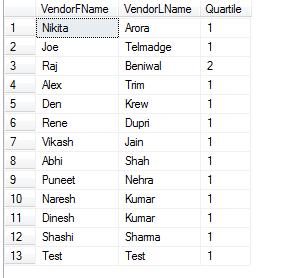
No comments:
Post a Comment